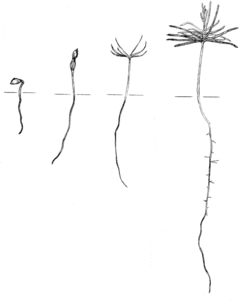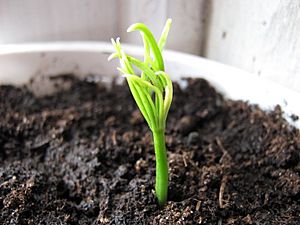Seedling facts for kids


A seedling is a young plant sporophyte developing out of a plant embryo from a seed. Seedling development starts with germination of the seed. A typical young seedling consists of three main parts: the radicle (embryonic root), the hypocotyl (embryonic shoot), and the cotyledons (seed leaves). The two classes of flowering plants (angiosperms) are distinguished by their numbers of seed leaves: monocotyledons (monocots) have one blade-shaped cotyledon, whereas dicotyledons (dicots) possess two round cotyledons. Gymnosperms are more varied. For example, pine seedlings have up to eight cotyledons. The seedlings of some flowering plants have no cotyledons at all. These are said to be acotyledons.
The plumule is the part of a seed embryo that develops into the shoot bearing the first true leaves of a plant. In most seeds, for example the sunflower, the plumule is a small conical structure without any leaf structure. Growth of the plumule does not occur until the cotyledons have grown above ground. This is epigeal germination. However, in seeds such as the broad bean, a leaf structure is visible on the plumule in the seed. These seeds develop by the plumule growing up through the soil with the cotyledons remaining below the surface. This is known as hypogeal germination.
Images for kids
-
Seedling of a dicot, Nandina domestica, showing two green cotyledon leaves, and the first "true" leaf with its distinct leaflets and red-green color.
-
A few days old Scots pine seedling, the seed still protecting the cotyledons.
-
Seedling of Quercus robur sprouting from its acorn.
See also
 In Spanish: Plántula para niños
In Spanish: Plántula para niños








